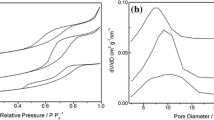Abstract
A novel solid superacid catalyst TiO2–Zr–La/SO4 2− was prepared by doping Zr and La to the bulk of TiO2. The modified TiO2–Zr–La/SO4 2− and the unmodified TiO2/SO4 2− were used to catalyze the esterification of acetic acid and n-butanol, in which these two catalysts were systematically compared in a lost of aspects such as catalytic activity and stability and so on. When a small amount of Zr and La were co-doped into the bulk of TiO2, the modified catalyst obtained a by far better catalytic activity and stability than the unmodified, showing that the modified is more resistive to deactivation than the unmodified. Under the set reaction conditions, the average conversion (of acetic acid) and the 20th-cycle conversion (of acetic acid) are 88.83 and 77.35 % for the modified, 80.83 and 46.15 % for the unmodified, respectively. The two catalysts were characterized by means of FTIR, XRD, BET, SEM, TG, and NH3-TPD methods to find the possible reasons for the superiority of the modified catalyst to the unmodified one. The characteristic results indicated that the incorporation of a small amount of Zr and La into the catalyst was beneficial to the modified catalyst: (1) improving its water-tolerance; (2) increasing its surface sulfate group content; (3) decreasing its crystallinity after calcination by retarding its crystallization from amorphous TiO2 to anatase TiO2; (4) increasing its specific surface area; (5) increasing its acidity including the concentration and acid strength of the surface acidic sites of it. All the above advantageous effects arisen from the two-element-doping are to be responsible for the substantially-improved catalytic performances of the modified catalyst.
Graphic Abstract








Similar content being viewed by others
References
Yamaguchi T (1990) Recent progress in solid superacid. Appl Catal 61(1):1–25
Sunajadevi KR, Sugunan S (2006) Selective nitration of phenol over sulfated titania systems prepared via sol–gel route. Mater Lett 60(29–30):3813–3817
Sohn JR, Lee SH, Lim JS (2006) New solid superacid catalyst prepared by doping ZrO2 with Ce and modifying with sulfate and its catalytic activity for acid catalysis. Catal Today 116(2):143–150
Miao C, Hua W, Chen J, Gao Z (1996) Sulfated binary and trinary oxide solid superacids. Sci China Ser B Chem 39(4):406–415
Jiang T, Zhao Q, Li M, Yin H (2008) Preparation of mesoporous titania solid superacid and its catalytic property. J Hazard Mater 159(2–3):204–209
Wang Z, Jiang T, Du Y, Chen K, Yin H (2006) Synthesis of mesoporous titania and the photocatalytic activity for decomposition of methyl orange. Mater Lett 60(20):2493–2496
Kartini I, Meredith P, Diniz Da Costa JC, Lu GQ (2004) A novel route to the synthesis of mesoporous titania with full anatase nanocrystalline domains. J Sol–Gel Sci Technol 31(1-3):185–189
Garg S, Soni K, Muthu Kumaran G, Bal R, Gora-Marek K, Gupta JK, Sharma LD, Murali Dhar G (2009) Acidity and catalytic activities of sulfated zirconia inside SBA-15. Catal Today 141(1–2):125–129
Mao W, Ma H, Wang B (2010) Mild ring-opening coupling of liquid-phase cyclohexane to diesel components using sulfated metal oxides. J Hazard Mater 176(1–3):361–366
Noda LK, Gonçalves NS, de Borba SM, Silveira JA (2007) Raman spectroscopy and thermal analysis of sulfated ZrO2 prepared by two synthesis routes. Vib Spectrosc 44(1):101–107
Fu B, Gao L, Niu L, Wei R, Xiao G (2009) Biodiesel from waste cooking oil via heterogeneous superacid catalyst SO4 2−/ZrO2. Energy Fuels 23(1):569–572
Li Z, Wnetrzak R, Kwapinski W, Leahy JJ (2012) Synthesis and characterization of sulfated TiO2 nanorods and ZrO2/TiO2 nanocomposites for the esterification of biobased organic acid. ACS Appl Mater Interfaces 4(9):4499–4505
Noda LK, de Almeida RM, Probst LFD, Gonçalves NS (2005) Characterization of sulfated TiO2 prepared by the sol–gel method and its catalytic activity in the n-hexane isomerization reaction. J Mol Catal A Chem 225(1):39–46
Porkodi K, Arokiamary SD (2007) Synthesis and spectroscopic characterization of nanostructured anatase titania: a photocatalyst. Mater Charact 58(6):495–503
Sohn JR, Kim J-G, Kwon T-D, Park EH (2002) Characterization of titanium sulfate supported on zirconia and activity for acid catalysis. Langmuir 18(5):1666–1673
Srinivasan R, Keogh RA, Davis BH (1995) Activation and characterization of Fe–Mn–SO4 2−/ZrO2 catalysts. Appl Catal A 130(2):135–155
Author information
Authors and Affiliations
Corresponding author
Rights and permissions
About this article
Cite this article
Shi, W. Zr–La Doped Sulfated Titania with a by Far Better Catalytic Activity and Stability than Pure Sulfated Titania in the Esterification of Acetic Acid and n-Butanol. Catal Lett 143, 732–738 (2013). https://doi.org/10.1007/s10562-013-1016-4
Received:
Accepted:
Published:
Issue Date:
DOI: https://doi.org/10.1007/s10562-013-1016-4




